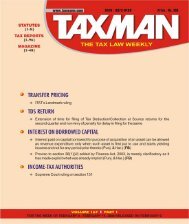CPT V24P7-Art1 (Content).pmd - Taxmann
CPT V24P7-Art1 (Content).pmd - Taxmann
CPT V24P7-Art1 (Content).pmd - Taxmann
You also want an ePaper? Increase the reach of your titles
YUMPU automatically turns print PDFs into web optimized ePapers that Google loves.
Direct Tax Laws<br />
Insurance Act, 1938. The profits of the insurance<br />
business while computing shall be increased<br />
by the aggregate of the accruals of the receipts<br />
calculated as per the provisions mentioned<br />
under section 33(2) of the draft Bill to the<br />
extent that such profits are not referred to in<br />
any other heads of profits and the amount of<br />
expenditure referred to under section 35(4)<br />
and the exceptions of finance charges referred<br />
to under section 36(2) of the draft Bill shall<br />
be considered as the deductions while computing<br />
profits of the insurance business. 60 While<br />
computing the profits, deductions mentioned<br />
under section 35(2)(xxx) which talks about<br />
contribution to any fund related to their<br />
employees shall also be taken into consideration. 61<br />
10.2 Computation of profits of non-life insurance<br />
business - The profits of the insurance business<br />
other than life insurance business shall be the<br />
profits disclosed in the annual accounts, the<br />
copies of which are deposited with the Controller<br />
of Insurance as per the provisions of the Insurance<br />
Act, 1938. 62 The increase in the profits and<br />
deductions made in the profits are same as<br />
calculated in the life insurance business. 63<br />
The profits of the branches in India of a person<br />
not resident in India and carrying on any<br />
business of insurance, may, in the absence of<br />
more reliable data, be deemed to be that<br />
proportion of the world income of such person<br />
which corresponds to the proportion which<br />
his premium income derived from India bears<br />
to his total premium income. 64<br />
The profit from the business of insurance shall<br />
be aggregated with unabsorbed preceding year’s<br />
loss from the business of insurance, if any,<br />
and the net result of such aggregation shall<br />
be the current profit from the business of<br />
insurance for the financial year. 65 The current<br />
profit from the business of insurance shall be<br />
treated as nil, if the net result of aggregation<br />
in profit is negative and the absolute value of<br />
the net result of the aggregation shall be the<br />
amount of unabsorbed current loss of the business<br />
of insurance for the financial year.<br />
666<br />
In this manner the total profit of the insurance<br />
business shall be calculated as per the different<br />
provisions of the Direct Tax Code Bill in<br />
consonance with the Insurance Act, 1938.<br />
CONCLUSION<br />
August 1 to 15, 2012 u TAXMANN’S CORPORATE PROFESSIONALS TODAY u Vol. 24 u 46<br />
11. It is evident from the present study that<br />
there is a need to tax the insurance businesses<br />
differently from other businesses. The same<br />
has been convincingly clarified by the Courts<br />
in various judgments while identifying the<br />
difficulties that might arise if the insurance<br />
businesses are taxed in the same model of<br />
taxing as the other businesses.<br />
However, inspite of these clarifications and<br />
reconciliations by both, the Courts as well as<br />
the Legislatures, the difficulties in ascertaining<br />
a stable model for taxing insurance businesses<br />
still persist.<br />
There are great difficulties in applying rule 2.<br />
This is because the term ‘annual average’ referred<br />
to in rule 2 has been left redundant, since<br />
actuarial valuation is carried out on yearly<br />
basis by insurance companies. Moreover, the<br />
term ‘Actuarial valuation’ is not defined in the<br />
Income-tax Act. Further, only policyholders’<br />
account is considered if prescribed Form is<br />
adopted as basis for taxation.<br />
Also, the computational provision, i.e., the rule<br />
2 of the First Schedule is capable of different<br />
interpretations.<br />
Further, the tax provisions have not kept pace<br />
with major regulatory changes brought about<br />
by IRDA, since there has been no amendment<br />
since 1976 to provide for uniform methodology<br />
for computation of profits from life insurance<br />
business.<br />
Moreover, the Central Government had in 2000<br />
formed a Committee under the Chairmanship<br />
of Justice V.U. Eradi to suggest necessary<br />
alterations in the present Income-tax Act, 1961<br />
in relation to the taxation of the Insurance<br />
Businesses. However, despite some significant<br />
alterations suggested by the Committee’s report,











![“FORM NO. 3CEB [See rule 10E] Report from an ... - Taxmann](https://img.yumpu.com/45480232/1/190x245/form-no-3ceb-see-rule-10e-report-from-an-taxmann.jpg?quality=85)





